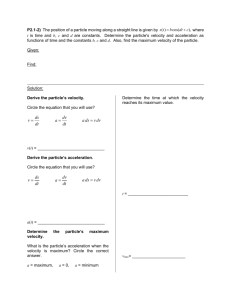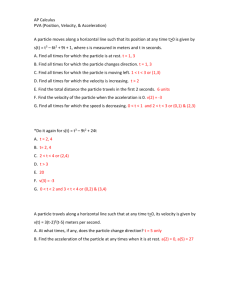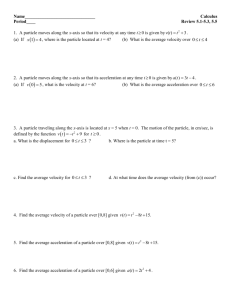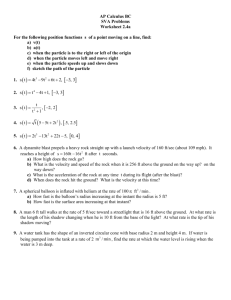MATH 1910 Section 3.3 Rates of Change in the Natural and Social
advertisement
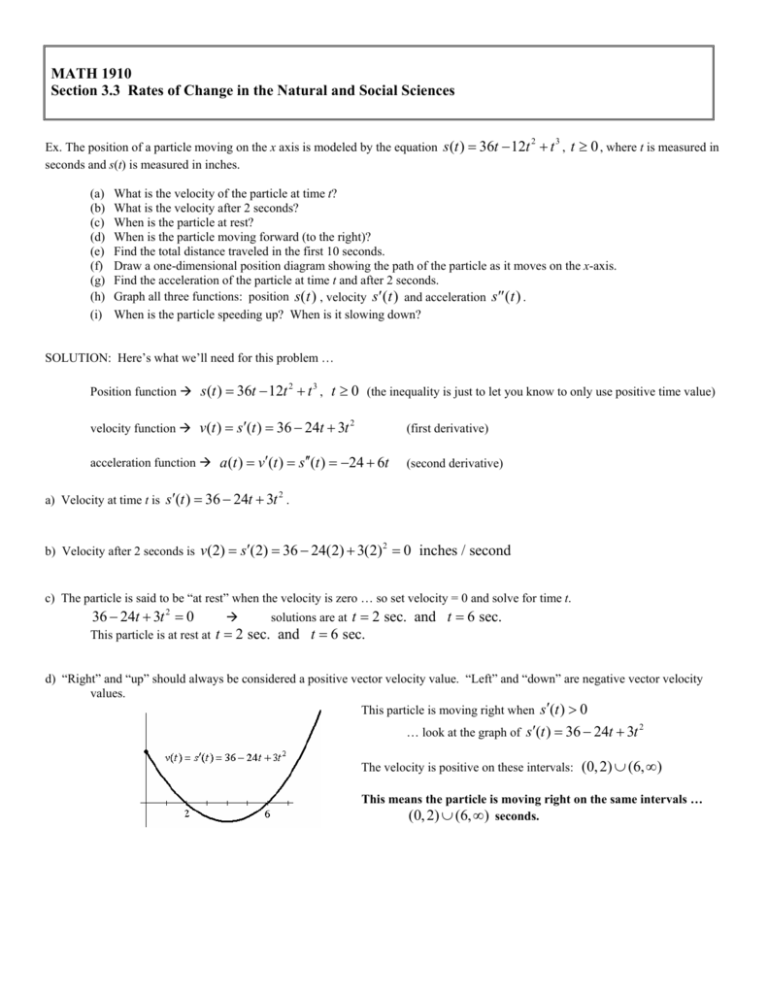
MATH 1910 Section 3.3 Rates of Change in the Natural and Social Sciences Ex. The position of a particle moving on the x axis is modeled by the equation s (t ) = 36t − 12t + t , t ≥ 0 , where t is measured in seconds and s(t) is measured in inches. 2 (a) (b) (c) (d) (e) (f) (g) (h) (i) 3 What is the velocity of the particle at time t? What is the velocity after 2 seconds? When is the particle at rest? When is the particle moving forward (to the right)? Find the total distance traveled in the first 10 seconds. Draw a one-dimensional position diagram showing the path of the particle as it moves on the x-axis. Find the acceleration of the particle at time t and after 2 seconds. Graph all three functions: position s( t ) , velocity s′ ( t ) and acceleration s′′( t ) . When is the particle speeding up? When is it slowing down? SOLUTION: Here’s what we’ll need for this problem … Position function Æ s (t ) = 36t − 12t + t , t ≥ 0 (the inequality is just to let you know to only use positive time value) 2 3 velocity function Æ v (t ) = s′(t ) = 36 − 24t + 3t 2 (first derivative) acceleration function Æ a (t ) = v′(t ) = s′′(t ) = −24 + 6t (second derivative) a) Velocity at time t is s′(t ) = 36 − 24t + 3t . 2 b) Velocity after 2 seconds is v (2) = s′(2) = 36 − 24(2) + 3(2) = 0 inches / second 2 c) The particle is said to be “at rest” when the velocity is zero … so set velocity = 0 and solve for time t. 36 − 24t + 3t 2 = 0 Æ solutions are at t = 2 sec. and t = 6 sec. This particle is at rest at t = 2 sec. and t = 6 sec. d) “Right” and “up” should always be considered a positive vector velocity value. “Left” and “down” are negative vector velocity values. This particle is moving right when s′(t ) > 0 … look at the graph of s′(t ) = 36 − 24t + 3t 2 The velocity is positive on these intervals: (0, 2) ∪ (6, ∞) This means the particle is moving right on the same intervals … (0, 2) ∪ (6, ∞) seconds. MATH 1910 Section 3.3 Rates of Change in the Natural and Social Sciences e) Be careful with this one … in the first 10 seconds of its travel, the particle turns around twice … once at 2 seconds and again at 6 seconds. You need to find the total distance in intervals … s (0) = 0 inches Å the particle starts at 0 inches. s (2) = 32 inches s (6) = 0 inches s (10) = 160 inches Å the particle is 32 inches to the right after 2 seconds Å the particle is back at 0 inches … where it started. Å at 10 seconds, the particle is 160 inches to the right of its starting point. So the total distance traveled is 32 + 32 + 160 = 224 inches f) The derivative graph helps to show the motion of the particle … moving right between t = 0 and t = 2 seconds … moving left between t = 2 and t = 6 seconds … moving right after 6 seconds using the position values from part (e) we can represent the actually 1-dimensional motion of this particle … g) The acceleration after 2 seconds is a (2) = s′′(2) = −24 + 6(2) = −12 inches/sec 2 h) g) The particle is “speeding up” when its acceleration and velocity have the same sign … Speeding up on the time interval between t = 2 and t = 4 seconds … and again after t = 6 seconds to infinity. The particle is slowing down when the velocity and acceleration have opposite signs Slowing down between t = 0 and t = 2 seconds … and between t = 4 and t = 6 seconds. MATH 1910 Section 3.3 Rates of Change in the Natural and Social Sciences Ex. A spherical balloon is being inflated. Find the rate of change of the volume, V when r is (a) 10 cm (b) 11 cm (c) 12 cm. = 4 πr 3 with respect to the radius r 3 What conclusions can you make? SOLUTION: The function V = 4 πr 3 defines the volume of the balloon as a function of its radius. 3 The derivative of this function gives the rate of change of volume with respect to the radius. V= (a) 4 πr 3 3 Æ 4π (3r 2 ) 3 ′ V = 4π r 2 V′ = V ′(10) = 4π (10) 2 = 400π cm3 per cm (meaning the volume is growing at a rate of . (b) V ′(11) = 4π (11) 2 = 484π cm3 per cm (c) V ′(12) = 4π (12) 2 = 576π cm3 per cm 400π cm3 per cm of radius length when the radius is 10 cm long.) Since the rate of change is increasing as the radius increases … the volume is obviously growing, but it is growing at an increasing rate. Ex. Boyle’s Law states that when a sample of gas is compressed at a constant temperature, the product of the pressure (in atmospheres, atm) and the volume remains constant: PV = C . (a) Find the rate of change of the pressure with respect to the volume. (b) What does the sign of the result from part (a) signify? SOLUTION: (a) PV = C Æ rewrite so that pressure is a function of volume Æ The rate of change of pressure with respect to volume is Æ P= C V P′ = C (−V −2 ) Æ P′ = − C V2 (b) The negative sign indicates the fact that pressure (as a function of volume) is a decreasing function. The more volume increases, the more pressure decreases which is also suggested by the inverse proportional relation P = C V MATH 1910 Section 3.3 Rates of Change in the Natural and Social Sciences Ex. Assume a certain physical phenomenon is modeled by the equation F = 5 A2 . Find … BC dF (this means assume that B and C are constants) dA dF (b) The rate of change of F with respect to B, (this means assume that A and C are constants) dB (a) The rate of change of F with respect to A, SOLUTION: (a) Isolate the variable A Æ F = 5 ⋅ A2 BC Æ dF = dA 5 10 A ⋅ (2 A) = BC BC (b) Isolate the variable B Æ F = 5A2 −1/ 2 ⋅B C Æ dF 5 A2 = dB C 2 1 5 A2 1 5A ⋅ B −3/ 2 = ⋅ = C 2 B 3 2 B 3C 2

